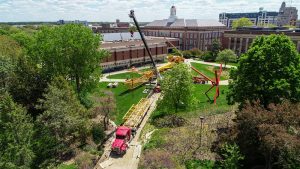Background
Deferred renewal backlog is an old subject for higher education facilities leaders, but one that, in our current reality, requires new emphasis. In April 2021, APPA released an estimate that higher education as a whole is facing urgent deferred renewal of more than $112 billion. That estimate is a brand new impetus for reviving the old backlog conversation. The Federal debate concerning the nation’s infrastructure needs—where higher education is very much in play—is helping to highlight the fact that higher education facilities infrastructure is critical if schools intend to keep educating students on physical campuses. But that’s only part of the context.
All of this comes at a time when financial instability is omnipresent. Global competition for students has never been greater, a very real enrollment crisis is looming, state support for higher education has diminished, philanthropic giving is in decline, and COVID-related expenses are acting as an accelerant to these increasing financial burdens. This compounding of risks means the case for change has never been more compelling.
That doesn’t mean we should give up on physical campuses, as colleges and universities continue to add value to society. Higher education contributes significantly to local, state, and federal economies by spurring innovation, addressing workforce reskilling, promoting public service, ensuring access for economically disparate populations, and of course, educating the citizenry. While a stable education delivery system from both a physical and technological infrastructure perspective is critical for the lifeblood of academe, our efforts must transcend requests for more money. There just isn’t a lot of extra cash floating around academic communities.
The Current Spending Reality
The research that led to that significant $112 billion backlog figure indicates that schools are already spending upwards of $37 billion annually to operate and maintain campus facilities. On top of that, nearly $28 billion is invested in construction of new facilities or renovation of existing facilities every year. Yet, these monies are nowhere near sufficient to care for the more than 6 billion sq. ft. and several hundred thousand buildings that comprise U.S. campuses, especially with the average building approaching 50 years of age. Hence, the ongoing accumulation of backlog is well beyond the lifecycle of all but the most durable building components.
How Stakeholders Experience Backlog
The daunting facilities backlog poses a serious risk to the ability of schools to deliver the high-quality, transformational experiences that higher education seeks to provide. These experiences extend beyond the classroom. The pandemic has taught us that community and connections with friends are what students want most from on-campus experiences. Therefore, it is critical that we examine space through a wider lens, both from a facilities perspective and an institutional perspective.
Backlogs of deferral are experienced by students and faculty as underachieving facilities that constrain their aspirations. Simply put, the buildings and their systems just don’t work when people need them to work. Worse yet, the physical deficiencies of a campus facility may represent significant health, safety, and reliability risks. Institutional risk and relative reliability should be front and center for student and faculty recruitment and retention, providing that warm and welcoming “sense of place” and delivering on the institution’s brand.
APPA’s estimates and the surrounding industry context clarify the risk to physical spaces. Combining that hard data with pandemic-era observations about student expectations of campuses magnifies the need to address existing backlogs. But how? The answer to this question can be split into two parts: “Catch Up” and “Keep Up.” The former requires addressing existing need, and the latter focuses on preventing backlog from accruing further.
Catching Up to Facilities Backlog

A large crane is being assembled west of Love Library. A summer project will close Love Library North, Adele Hall Learning Commons and the Love Library Link starting May 7. The project will remove deteriorating decorative structures — massive precast concrete panels and metal screens — that adorn the roofline of Love North. May 12, 2021. Photo by Craig Chandler / University Communication. Photo Credit: Craig Chandler | University Communication
As stated earlier, this is not the time to assume that money will be immediately forthcoming. But such allocations are not impossibilities. Recently, the State of Nebraska’s university system reviewed its situation through a series of evaluations that led it to set aside nearly $400 million for future facilities upgrades and renovations. The university system understood the scale of its need and made an investment commitment to do the work and create a timeline for making those funds available. Decision makers are now hard at work determining how to allocate the investment. The sequence of events is important to the success of the system’s efforts. A targeted and detailed assessment of needs, as well as a thoughtful deployment strategy across the system’s entire portfolio, can be undertaken more effectively if the level of commitment to do the work is understood. Broad commitment leads to informed action.
Florida State University is taking another pathway to deployment after revisiting a master plan they created before the pandemic. In the days since the pandemic, leaders have reframed the focus of the master plan, scaled back growth plans, and made clear the need to invest in existing properties with an eye toward making them more productive pieces of the existing academic plan. This focus on stewardship of existing resources offers the potential to optimize existing assets before expanding the current portfolio. The backlog data at the start of this report demonstrates that the national portfolio has already been underfunded and could benefit from a similar strategy.
This stewardship-first strategy has led institutions such as those comprising the University of Maine System to implement “no net new space” policies. “No net new” means that new construction can and should take place where it is the wisest way to address a problem. But “no net new” commits the institution to removing an equivalent amount of space that was deemed unworthy of investment to support the school’s future. Such strategies have multiple benefits for addressing backlog.
First and foremost, this kind of strategy doesn’t increase the amount of space to be maintained with increasingly strapped operational resources. Instead, the approach begins to temper the operating thirst of the campus, giving administrative leaders a chance to rebalance budgets and expenditures. Secondly, it refocuses finances toward the deferral on existing buildings and systems. It forces questions around whether an existing building should be invested in, for whom, and to what extent. Thirdly, it opens the door to replacement while not setting new construction in opposition to caring for the existing portfolio. And finally, in the University of Maine System at least, the Board of Trustees importantly retains the right to add to the portfolio if there is demonstrated justification.
It’s really about trying to rightsize the footprint of campus, to get what we think we need and what the future holds, knowing that the pandemic and how we emerge from that and the new norm could impact us even more… We’re really not talking just about contraction, we’re talking about [making] the right investments…recognizing the importance of investing in the academic program as well… We believe that the physical environment of the campus is important to student learning and success. – Nathan Mortimer, University of Akron, The Key with Inside Higher Ed Podcast.
More dramatic plans are underway at several institutions. A thorough evaluation of space condition, space utilization, and capital capacity at the University of Iowa revealed a rarely-seized-upon opportunity to reduce campus size. The evaluation made it clear that five buildings that were already underserving their programs could be eliminated if appropriate attention were paid to addressing needs in buildings that could effectively meet campus programming going forward.
Until recently, it has been extremely unusual to see such bold steps taken on campuses where more has always been perceived to be better. But this same exercise is being explored at the University of Missouri and the University of Akron, and very likely will be contemplated by more institutions in the wake of a pandemic that is rewriting the rules around how much space is needed to deliver students both the highest-quality education and a top-notch experience.
All of these strategies—conducting assessments, focusing on existing portfolio, “no net new spaces,” and divestment of assets—are designed to help campuses catch up to their backlog. And while facilities leaders may feel confident in the right path forward, senior leadership is undoubtedly going to have questions about any strategy’s return on investment. To that end, facilities professionals need to provide good data analytics and insights by using planning metrics and models, so institutional leaders remain strategic in this increasingly competitive environment. The stakes have never been higher.
Catching up to backlog is only half the battle. Next, we’ll explore how to keep up with facilities needs and steward campus spaces for long-term success.
Advertisement – article continues below
Keeping Up with Facilities Backlog
The backlog of need facing campuses is the accumulation of incremental underinvestment or underfunded expansion over an extended period. These needs won’t go away quickly, no matter which solutions are seized upon. But they will return immediately if schools don’t take a hard look at the balance of investments going forward. Colleges and universities should implement some obvious, albeit challenging, practices to keep their facilities on solid footing.
- Don’t build more than you can afford. Don’t add to the campus building portfolio with any capital source unless you can match it with operational spending increases.
- Confirm that operating funds are being optimally invested. While there are no perfect measures of what is optimal, it is possible to determine if spending is markedly out of line.
- Look for ways to align spending by reducing operating demands or increasing operating investment. The goal is balance.
- Review assets to ensure they are fully supporting campus programs. Focus operational and capital investment where the efficiency and effectiveness of existing assets can be maximized.
- Communicate coherently to the entire campus community. Publicize, without jargon, the current state of affairs in your effort to steward the building portfolio and find balance in spending and investment.
These are, admittedly, not sophisticated ideas. Thoughtful leaders will see them as relatively common-sense activities. But common sense does not necessarily equal common practice. The same leaders who would describe the activities listed above as elementary will likely recognize that these ideas are not being routinely practiced on their campus. But they can be, and they have been.
In the relatively short-term crisis of the pandemic, campuses embraced broad collaboration to get students and faculty back to campus. There is much to learn from this experience. The long-term challenge of unaddressed backlog will require the same collaborative approach and a similar sense of urgency with a new mindset of “doing different with less.”
The Way Forward
With roughly $2 trillion in building assets across the whole of higher education, the nation has made an extraordinary commitment to higher education. Colleges and universities have been the engine driving innovation, economic growth, and social prosperity since higher education appeared in Cambridge, Massachusetts, in the middle of the seventeenth century, was expanded significantly by land-grant institutions across the country, and accelerated rapidly after World War II. While the pandemic has raised the specter of dramatic shifts in the way higher education happens, there is little indication that we will see the demise of campus-based education as a concept. Yet those campuses require stewardship.
The old backlog conversation is due for a fresh look, a reframing that considers the impacts of the pandemic and the $112 billion in deferred renewal looming over American campuses. It will take the same bold leadership that schools espouse as an attribute of their finest graduates to not only address deferral, but to establish new, disciplined financial and facilities practices that will sustain their communities for the foreseeable future. Connecting academic program plans with finance and facilities plans as an integrated strategic planning approach to addressing needs and priorities will enhance our chances of success. The time for action is now.
About Gordian
Gordian is the world’s leading provider of facility and construction cost data, software, and services for all phases of the building lifecycle. From planning to design, procurement, construction and operations, Gordian delivers groundbreaking solutions to contractors, architects, engineers, business and financial officers, and facility owners in local, state, and federal governments, education, healthcare, and other industries. A pioneer of job order contracting (JOC), Gordian also offers the proprietary RSMeans data and Sightlines Facility Intelligence solutions.
About APPA
APPA (www.appa.org) is the gathering place for educational facilities professionals, dedicated to the ongoing evolution of the profession. APPA represents more than 17,000 educational facilities professionals from over 1,300 learning institutions worldwide. APPA’s community represents the broadest coalition of educational facilities professionals possible, ensuring a diversity of experiences and situations as well as the availability of best practices. APPA members also include other nonprofits, libraries, museums, and industry partners.
Pete Zuraw is vice president of market strategy and development with Gordian, and can be reached at [email protected]. This is his first article for Facilities Manager. Lander Medlin is APPA’s president and CEO and can be reached at [email protected].




